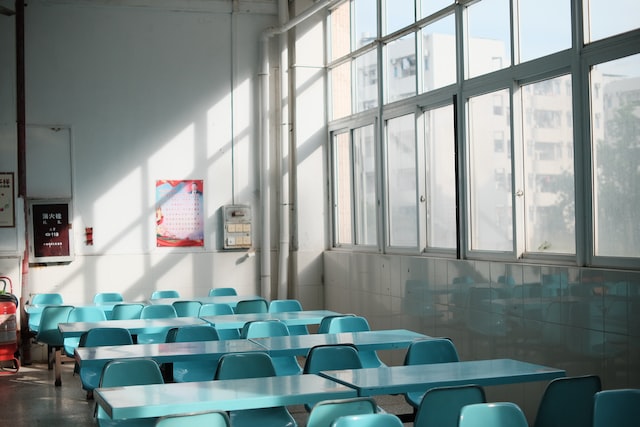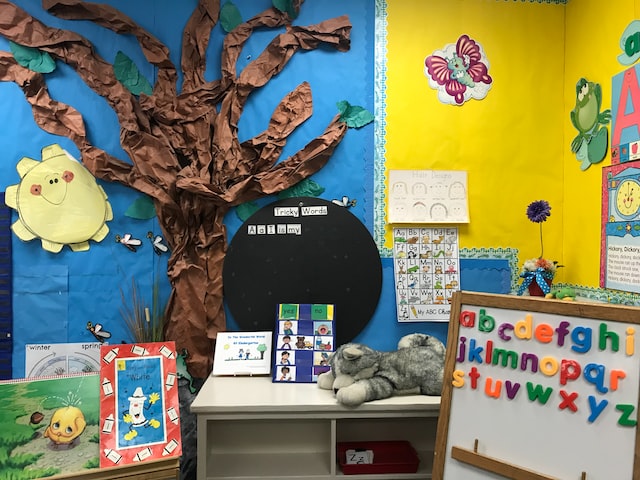Table of Contents
Decorating a classroom can be a fun way to brighten it up and have useful learning tools always at hand. However, research suggests that teachers should be careful when choosing classroom decoration as too much of the wrong kind of decoration can be distracting to students’ learning.
This does not mean that classroom walls should necessarily be totally bare, but many classrooms are a sensory overload with floor to ceiling maps, charts, letters, and pictures. Teachers should instead be more mindful with what they display in the classroom walls in order to not create distraction from their lessons.
This article will discuss several research studies on classroom environment and help teachers prepare a welcoming, but not distracting classroom.
Research on Classroom Decoration
A study conducted at Carnegie Mellon University sought to understand the effect of classroom decoration on kindergarten aged students. The researchers created two groups of 12 students and had them get acquainted with the teacher before jumping into a series of lessons.
One group was taught in a room with a large amount of decorations and the other group was taught in a room with no decorations (See image below). The results showed that students learned significantly less in the highly decorated room when compared with the sparsely decorated room. (Fisher et al.)
This effect was also found to affect a vast majority of students, with 85% of students being distracted by the decorations. This shows that it is not just easily distractible students or those with certain conditions who are distracted by classroom decorations during lessons, but something that has an impact on almost all students’ ability to focus.
The researchers noted that their “manipulation affected the vast majority of kids” but also cautioned that they “don’t mean this is the silver bullet” for solving student distractibility. Students in the highly decorated rooms were more distracted by the decorations, but students in the sparsely decorated room were more likely to be distracted by themselves or other students.
When taking a look at all of the time spent off task however, students spent more time on task when they were not in a highly decorated room. That coupled with the lower learning showed by the students in the highly decorated room suggests that teachers should be wary of too much decoration, especially when the decorations are irrelevant to the ongoing instruction.
This is by no means the only study to have found similar results on overly decorated spaces being distracting. Another similar study found that this distractibility was also a factor for older students. (Rodrigues, and Pandeirada)
In this study on 64 students aged 8-12, some students completed cognitive tasks on a computer on a desk with lots of pictures and displays while other students worked at a desk surrounded by nothing but white walls. (See image below)
“Overall, the results suggested that the high-load visual environment affected children’s cognitive performance given that children performed better in the low-load visual environment”. (Rodrigues, and Pandeirada) These studies highlight the effect visually stimulating environments have on learning.
Research Based Tips for Classroom Decoration
While it might be easy to go overboard with too many decorations, other research has been done that gives some clear guidelines on what type of environment is most beneficial for student learning. (Barrett et al.) A classroom does not need to be a pure white walled prison or a glass fishbowl to be effective and not distract students.
Use colors to create beauty rather than shapes, pictures, and designs.
Think of the wild floral patterns on wallpapers that were popular in the 1960s and 70s. While the visual stimulation can be interesting, it also can be quite hard for the eye to find a place to rest.
Classrooms, while not often decorated with hippie wallpaper, can still not give the eye anywhere to rest between the quotes, pictures, maps, charts, and other shapes and designs. Instead, teachers should go with a modern aesthetic that focuses on statement pieces and bold colors.
Using a single bold color and adding furniture that accents or matches well will still lend itself to making a room inviting without being overwhelming. These brightly colored walls can then be used to put up single charts and displays that are relevant to what is being taught in that lesson.
Decorate classrooms for the month or week rather than the entire year.
Rather than trying to decorate once with everything that might be helpful for the entire year, teachers should be more mindful about whether what they have displayed is relevant to the current lessons or not. While powerful quotes can be inspiring, teachers don’t want students to be reading quotes or looking over maps during the math lesson.
Instead, teachers should try to put up one or two “statement pieces” of decoration that will help students gain a better understanding about what the teacher is discussing. Not only does this keep students from mindlessly scanning the room for something to distract themselves with when bored, it also highlights those pieces more, ensuring every student sees, reads, and truly digests what that decorative map, chart, or quote has to teach.
While it can be hard to constantly be redecorating, if the teacher only has one or two decorations per wall, it is much easier to switch those out and freshen up the room. Students will notice the change, and begin to be exposed to the content relevant to the upcoming lesson.
Display student work in the halls.
One type of decoration that adorns almost every teacher’s classroom walls is student work. While it might seem like a no brainer to show how proud the teacher is of student work by displaying it in the classroom, this can have several unintended consequences.
Not only does this give students something from past lessons to look at rather than focusing on the current lesson, it can also lead to comparison and judgment. Most student work is all displayed one right next to the other in one section of the room.
This leads to direct comparison, especially when not all students’ work is the same quality. This can make some students uncomfortable and lead others to having unkind thoughts that might get expressed later on.
A much better way to display student work to show how proud the teacher is is by displaying it around the halls outside of the classroom. This helps to keep distractions out, but also gives a lot more space to intersperse work from various projects to avoid comparison and highlight each piece of work as something to be equally proud of.
Cleanliness is more important than classroom decoration.
One of the reasons teachers claim it is important to display student work in the classroom is to give them ownership of the classroom. While research backs up this assertion that students need to feel ownership over their classroom, there are better ways to create ownership than just displaying work on the walls.
Another way, practiced regularly in Japan is having students clean up their own classroom. While teachers will generally have some time for students to pick items up off the floor and desk, they still usually rely on school janitors to vacuum, wipe surfaces, and do other deep cleaning.
This teaches students that they can make a mess and it doesn’t really matter as it is someone else’s job to clean up their messes. Instead, setting aside mindful time to have each student deep clean their space each day will teach them that any mess they create they have to clean up.
This will simultaneously create a sense of ownership over their space and classroom, but also keep the room neat, organized, and ready for learning. While not decoration, this cleanliness has a significant impact on the classroom environment and there is much research on the importance of a clean and organized space for learning.
While this may take a significant amount of time, teaching students to take responsibility and not expect others to clean up after them is a far more important life lesson than any content they could be learning.
This is especially important in elementary school where messes are frequent and can add up quickly, older students may not have been taught to respect their space earlier in life. As they will be less likely to create giant messes, it should take them less time to keep it nice each day.
Avoiding clutter is not just the students’ job however. The teacher needs to do their part to keep the classroom from feeling cluttered.
Part of this is not decorating rooms with items that take up a lot of space or create mess. Teachers should avoid decorations with glitter, large decorations that take up a lot of space and make transitions difficult, and things that hang from the ceiling.
Focus on temperature, light, and air quality over aesthetics.
Research shows that while a nice room is important for student learning, teacher funding is extremely limited and money is far better spent on things that create light and adjust the temperature and air quality instead of decorations. Rooms should be well lit, reasonably cool, and free of dust and allergens.

Well lit classrooms are not just important for students to be able to see, but also affect their alertness by targeting students’ circadian rhythms. Natural light from outside is always best, but research shows that high quality electric lights can be a fine substitute when natural light is unavailable due to the time of day or location of the classroom in the building.
Another thing to keep in mind is to avoid glare on the screen or board. Glare from poorly placed lights can keep students from being able to see in certain seats. Teachers should sit in each seat and ensure that students can see and that various light conditions do not block their view of what the teacher is displaying.
Other things teachers could spend their decoration budget on are space heaters, mobile ACs or fans, air purifiers, and humidifiers. These devices can often be surprisingly cheap as can be seen from the links above.
Any teacher who has had to teach in a hot room knows how it can completely sap the energy of even the most active students. A freezing cold room also keeps students from being able to properly focus. Similarly, students who are sneezing from allergies or have dry eyes or skin will be focusing on feeling bad rather than focusing on learning the lesson.
While not technically decorations, these devices are far more important to creating a good learning environment than displays on the walls or ceilings. While teachers may feel it is the administrator’s job to control the air and temperature of the school, experience reveals that they are often more concerned about the electric bill than keeping every room at an appropriate temperature.
Keeping small devices that affect only one classroom not only allows teachers to not have to rely on stingy admin, but also allows them to individualize temperature for each class. Some people prefer slightly cooler rooms while others want it much warmer. When the teacher can make small adjustments to a device in their room, it allows for much more control over their space.
Conclusion
In conclusion, while classroom decoration can be a very fun part of being a teacher and help them to express themselves, it is important that they not go overboard and create distractions. Rooms should have a more modern, minimalist aesthetic paired with a clean room that gives plenty of space to move around during transitions.
When the room only has a few statement pieces, students will pay more mindful attention to them and teachers can have more space for transitions, break out groups, and not distract students with work from past lessons. While ownership of the room is important, students’ work should be kept out in the halls. This will give students more ownership of their entire school and cause them to try harder as they know it will be publicly displayed as school decoration rather than just classroom decoration.
Air temperature and quality is far more important to control than having a brightly decorated room. Keeping the temperature comfortable to avoid shivering or falling asleep in a pool of sweat will keep students alert and able to focus. Similarly bright, well lit rooms can affect students’ feeling of being awake. Starting the morning in a bright, naturally lit room is best, but even some nice high quality electric lights can give the morning energy students need to do their best.
Want more like this? Make Lab to Class a part of your weekly professional development schedule by subscribing to updates below.
References
Barrett, Peter et al. “The Impact Of Classroom Design On Pupils’ Learning: Final Results Of A Holistic, Multi-Level Analysis”. Building And Environment, vol 89, 2015, pp. 118-133. Elsevier BV, https://doi.org/10.1016/j.buildenv.2015.02.013.
Fisher, Anna V. et al. “Visual Environment, Attention Allocation, And Learning In Young Children”. Psychological Science, vol 25, no. 7, 2014, pp. 1362-1370. SAGE Publications, https://doi.org/10.1177/0956797614533801.Rodrigues, Pedro F.S., and Josefa N.S. Pandeirada. “When Visual Stimulation Of The Surrounding Environment Affects Children’S Cognitive Performance”. Journal Of Experimental Child Psychology, vol 176, 2018, pp. 140-149. Elsevier BV, https://doi.org/10.1016/j.jecp.2018.07.014.



